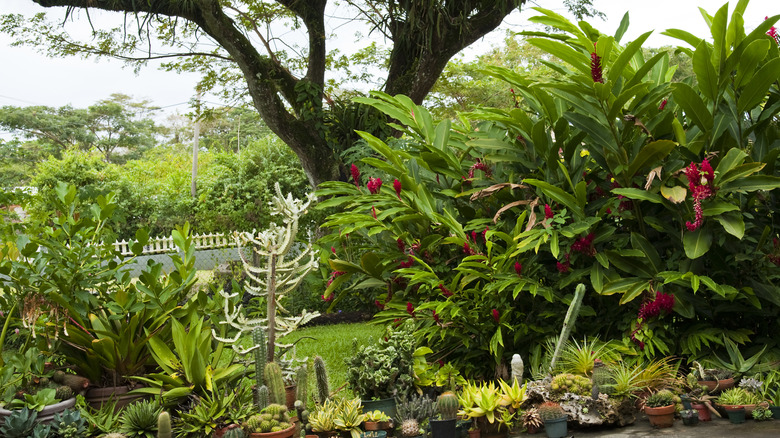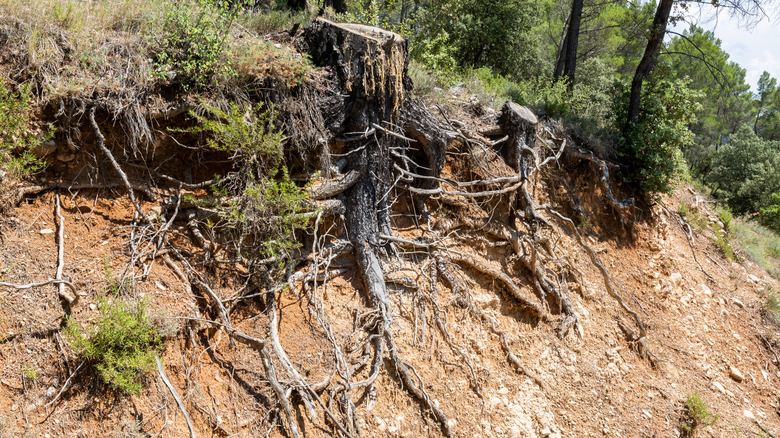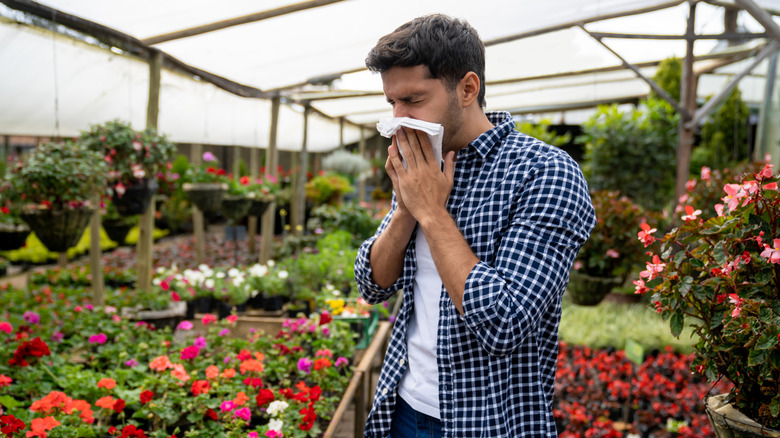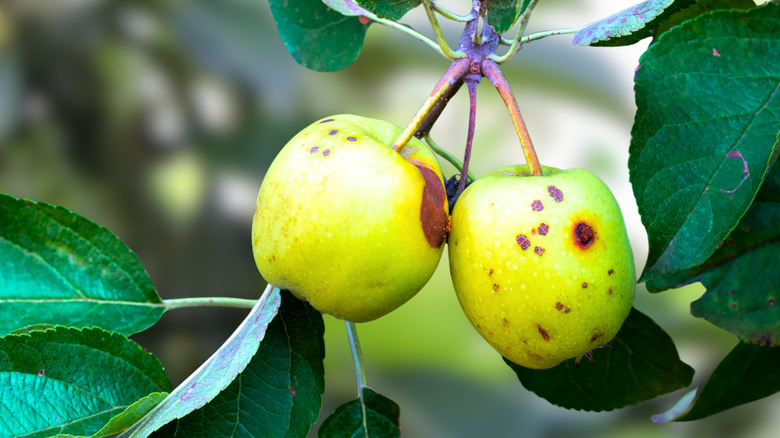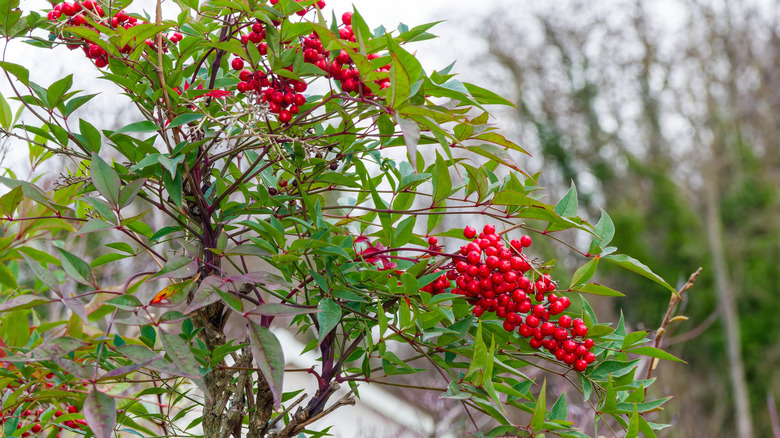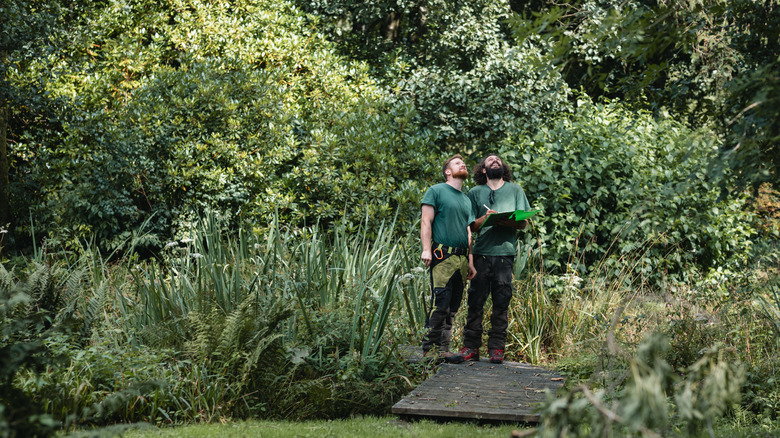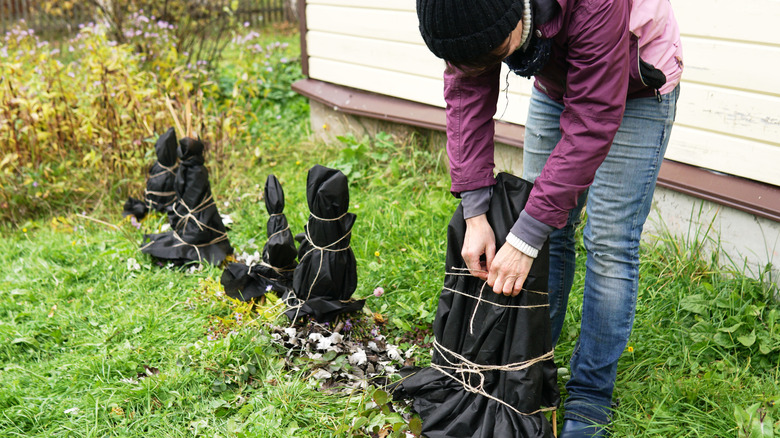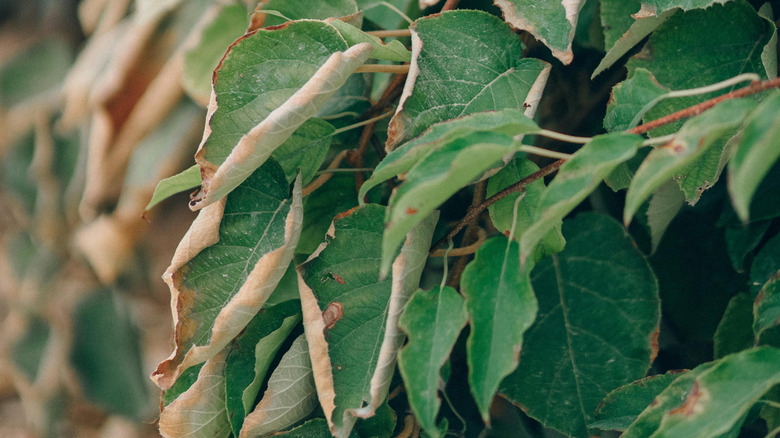Disadvantages Of Growing Non-Native Plants Every Gardener Should Know
We may receive a commission on purchases made from links.
Gardening is a fulfilling hobby that not only boosts your curb appeal but lets you flex your creative muscles. Different plants add different colors and textures to your yard, letting you play with moods and vignettes. And the more you experiment different species, the more adventurous you might become. This may lead you to want to plant non-native species that are both challenging and uncommon in your local area.
But before doing so, you should consider the potential caveats to cultivating international trees, shrubs, and flowers. There are many disadvantages to growing non-native plants that affect you and the world around you. They make gardening more challenging and expensive, as it may take more work, experimentation, and general upkeep to keep these plants alive and healthy. On the other side of the coin, non-native plants also have the potential to become invasive in your area, choking out local flora.
It's ironic how non-native plants go either one of two ways. They flourish too easily and destroy the native, natural environment, or they struggle to survive in a climate so different from their homeland. In either case, you should know how to approach these issues with care and finesse, ensuring you take the proper steps to grow or not grow non-native plants as you see fit.
Non-native plants overtake and kill off native plants by competing for natural resources
The biggest concern when planting non-native plants in outdoor gardens is that they potentially endanger local ecosystems. Many invasive plants have characteristics that make them a threat to the natural order. The most dangerous ones are often annuals or biennials that produce large quantities of seeds that spread easily via wildlife and wind. These plants germinate easily, grow rapidly and densely, and are hardy to changes in their climate and soil. As they begin to take over, they compete with neighboring native plants for nutrients, space, sunlight, and water, oftentimes killing them. In turn, this also impacts wildlife and insect populations since their food sources get wiped clean.
This issue has been seen in history many times, especially during the 18th and 19th centuries when European colonists imported plants from overseas. However, humankind hasn't learned from these mistakes, as many continue putting the environment at risk. According to a "Frontiers in Ecology and the Environment" study, 61% of 1,285 invasive United States plant species are still available for sale. If an amateur gardener picks up an exotic species from an unethical plant seller, they could unknowingly contribute to the invasive species problem. The best way to avoid this is to look for native plants at local nurseries and avoid exotic plants advertised as fast-growing and low-maintenance. However, keep in mind that not all non-native plants are a risk, and just because one plant is invasive in one region doesn't mean it will be invasive in another. You simply need to do your research before picking anything up from the nursery and planting it in your yard.
Non-native plants cause erosion and reduce flood control
When invasive plants outcompete natural plants for resources, they harm the physical world around them. Native plant root systems have adapted to support the land they live on and hold soil in place during heavy rain, wind, and other natural erosion events. When invasive plants plow through and take over native plants, original root systems weaken and degrade, leading to soil erosion and diminished flood control in local environments.
The best way to avoid this is by not growing any fast-growing and hardy alien plants. If you already cultivated an invasive species and think it will contribute to your property's soil erosion, be meticulous in disposing of it. Bag up the roots, seeds, and soil in a sealed plastic bag and leave it in direct sunlight for several weeks. This process is called solarization and ensures all living plant pieces are fried and won't be a threat if the bag is accidentally opened. Again, you can grow non-native plants in certain circumstances, but you should know the difference between non-native and invasive plants. Above all else, don't support nurseries that sell invasive species without warning customers of potential consequences. Popular retailers and gardening centers still sell threatening plants despite backlash from gardening communities, and it's up to individuals to make sure they aren't making landscaping decisions that harm the environment.
Non-native plants potentially bring new allergens to your area
Springtime is often glorified for its beautiful flowers and warm weather. Blooming plants add beauty and color to the world but also release large amounts of pollen that can trigger sinus and respiratory issues for allergy sufferers. Native grasses, trees, and weeds already carry plenty of pollen, but gardeners can accidentally add to the slough by planting non-native plants. Many of them are known for their allergy risks, and some — like ragweed — can release pollen that can travel up to 400 miles in windy conditions, potentially impeding the health of people far away.
Avoid introducing new allergies to your area by avoiding certain plants. In flower gardens, refrain from planting daisies, which spread quickly and are known for their pollen-riddled flowers. You should also avoid planting shrubs like western juniper, and trees like white mulberry. Instead, cross-reference native United States plants using Wildflower.org's Native Plants of North America Lists and your local university extension's list of recommended little-to-no-pollen plants to ensure you're planting a healthy and environmentally-friendly option in your yard.
Non-native plants don't have natural pest control
Native plants have defensive characteristics that protect them against pests in their natural environments. These defenses may be waxy leaf coatings, pointy thorns along their stems, toxic sap, or an overall thick structure that impedes larger wildlife and insects. Non-native plants don't have the same wildlife and insects in their homeland, making them incapable of fighting off new threats on their own. For example, Asian pear trees are hard to raise in certain areas throughout the United States because they're prone to codling moths, which flourish in warm and humid temperatures. Codling moths are drawn to fruit, and Asian pears produce theirs during peak summer, making them prime real estate for these moths.
In an effort to protect non-native plants from such pests, many gardeners resort to harmful pesticides. However, systemic pest control insecticides have many disadvantages in gardens, such as poisoning all insects, not just the "bad bugs," and their chemicals leaching into the soil. Instead of defaulting to dangerous pesticides, gardeners should start with a more natural approach if they want to continue growing non-native species. Try spraying neem oil, which disrupts insects' natural processes. Also try rubbing insecticidal soap over plant leaves, which has a similar effect as neem oil.
Non-native plants may have toxic flowers or berries that kill local wildlife
Many people plant ornamental gardens hoping to attract beautiful birds to their yards. So, the last thing anyone wants is to realize that their gorgeous and non-native plant contains toxic berries and fruits that adversely affect local bird populations. This isn't an outlandish possibility. For example, it's believed that berries from the exotic Nandina bush directly harm native bird populations. These berries contain cyanide, which is harmful when ingested in large amounts. Native berries don't contain the same toxins, making birds unaware that they're putting themselves at harm when they gorge on these fruits. Further research has revealed that not all birds are affected by the cyanide, since they don't eat enough to feel the effects. However, there's nothing stopping birds from eating more berries if native food sources are scarce — which is a common occurrence when non-native plants are introduced into ecosystems.
The best way to keep birds from accidentally poisoning themselves on toxic fruits is to replace foreign plants with native alternatives. The eastern red cedar and black chokeberry plants grow naturally in much of the eastern United States, making them a great substitute. There are many other shrubs that attract birds to your growing garden, but you'll need to ensure you've found a native berry bush by cross-referencing this list with your own location's natural foliage.
It's harder to maintain a cohesive and aesthetically pleasing landscape
One of the best tips for growing a healthy garden is to raise compatible plants that naturally co-exist. This is most commonly seen in a native landscape, where plants are adapted to thrive alongside other local plants, insects, and wildlife. Plants from the same areas share a common aesthetic, making it easy to create a mellow xeriscape theme or a vivid tropical landscape, depending on where you live. In fact, the National Wildlife Federation recommends that home gardeners try to plant at least 70% native plants to ensure flowering across multiple seasons. Some non-native plants may struggle to survive, causing unreliable blooms and an incohesive landscape. An exotic garden also doesn't connect to the natural beauty outside of property lines. Don't forget that beyond your yard, the natural environment still exists. An invasive plant garden isn't going to seamlessly mesh with the natural trees, shrubs, and flowers beyond its borders. This can make your yard look messy, unorganized, and purposeless.
At the end of the day, the natural solution to this is to look for native plants to adorn your landscape. Natural biodiversity is higher than you may realize, and most of the United States is home to thousands of plant species. Unless you're living in the Death Valley of California and Nevada or some other barren, plant-less land, it won't be difficult to incorporate native greenery into your landscape.
Foreign plants may not be able to survive the winters or winters won't meet the right chilling requirements
Winters are the most perilous time of year for plants, and even native species can struggle to survive the local climate they're built for. When colder seasons come around, gardeners must take action to protect non-native plants from frost and snow. The best way to ensure non-native plant survival is to optimize their nutrition, sunlight, and watering so they're healthy enough to push through the winter ahead. However, this is more time and money on your part. Many gardeners also provide physical protection by moving potted plants inside garages, sheds, and covered porches. Foliage rooted directly in outdoor soil must be covered with blankets, towels, tarps, or other covers explicitly designed to protect them from frost, such as the MAQIHAN Plant Cover Freeze Protection. Install MAXPACE Greenhouse Hoops or Wider Grow Tunnel over plants that are susceptible to winter temperatures all season long so they're protected, ventilated, and sunlit for the many weeks ahead.
On the other end of the spectrum, foreign plants can also struggle during the winter because they don't get cold enough. Many shrubs and trees need temperatures between 32°F and 45°F for many hours in order to bloom with flowers, fruit, and healthy leaves in the coming year. This is referred to as the "chilling hour requirement." If you live in a warmer climate, choose low-chill varieties that need less than 500 chilling hours to increase your success.
Humidity may be too extreme or the weather may be too dry for non-native plants to stay healthy
Humidity is more vital to plants than you may realize. Foliage from different growing zones is adapted for low or high humidity, which affects how well they retain and transpire water. Tropical plants are adapted to high humidity, which reduces how much water evaporates through their leaves. When in low-humidity environments, their transpiration rates go up, quickly dehydrating and drying them out. Arid plants are adjusted to the opposite conditions, and high humidity makes them more prone to overwatering and excessive moisture.
It's easier to adjust potted plants' humidity exposure, since you can move them into controlled environments. Transfer struggling non-native plants to pots so they can be moved indoors or to portable greenhouses for better climate control. Use the Home-Complete 4 Tier Mini Greenhouse to grow saplings and sprouts, or use the SUNGIFT Walk-In Greenhouse for Outdoors to house potted trees and shrubs. Once in a controlled environment, it's easier to add humidity by installing humidifiers, putting more plants closer together, or filling small plant saucers with water so they slowly evaporate and add water to the surrounding air. Reducing humidity for arid plants requires a different set of steps and is also harder to do with outdoor plants. Start by reducing the watering routine and putting more space between plantings. However, if your climate is too humid and the plant is suffering, you might need to admit defeat and remove them from your design.
